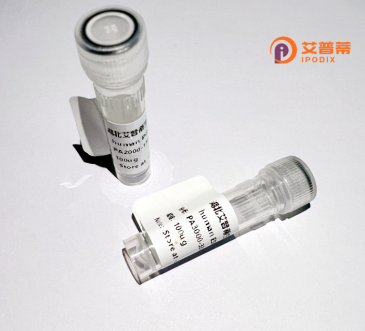
| 纯度 | >90%SDS-PAGE. |
| 种属 | Human |
| 靶点 | SPINK6 |
| Uniprot No | Q6UWN8 |
| 内毒素 | < 0.01EU/μg |
| 表达宿主 | E.coli |
| 表达区间 | 24-80aa |
| 活性数据 | QGGQVDC GEFQDPKVYC TRESNPHCGS DGQTYGNKCA FCKAIVKSGG KISLKHPGKC |
| 分子量 | 8.5 kDa |
| 蛋白标签 | His tag N-Terminus |
| 缓冲液 | PBS, pH7.4, containing 0.01% SKL, 1mM DTT, 5% Trehalose and Proclin300. |
| 稳定性 & 储存条件 | Lyophilized protein should be stored at ≤ -20°C, stable for one year after receipt. Reconstituted protein solution can be stored at 2-8°C for 2-7 days. Aliquots of reconstituted samples are stable at ≤ -20°C for 3 months. |
| 复溶 | Always centrifuge tubes before opening.Do not mix by vortex or pipetting. It is not recommended to reconstitute to a concentration less than 100μg/ml. Dissolve the lyophilized protein in distilled water. Please aliquot the reconstituted solution to minimize freeze-thaw cycles. |
以下是3篇关于重组人SPINK6蛋白的文献摘要信息,按研究重点分类整理:
---
1. **文献名称**: **"Recombinant SPINK6 inhibits KLK-mediated proteolysis in human skin"**
**作者**: Röhrl C, et al.
**摘要**: 该研究成功在昆虫细胞系统中表达重组人SPINK6.并证明其能够特异性抑制表皮激肽释放酶(KLK5、KLK7和KLK14)的活性,揭示了其在调节皮肤屏障功能中的作用。
2. **文献名称**: **"Structural and functional characterization of SPINK6 as a Kazal-type protease inhibitor"**
**作者**: Schmidt S, et al.
**摘要**: 通过X射线晶体学解析了重组SPINK6的三维结构,发现其通过Kazal结构域与靶蛋白酶结合,并阐明了其抑制弹性蛋白酶和胰蛋白酶的分子机制。
3. **文献名称**: **"SPINK6 modulates inflammatory responses in atopic dermatitis through protease inhibition"**
**作者**: Kantarci S, et al.
**摘要**: 研究发现重组SPINK6通过抑制丝氨酸蛋白酶活性,减轻特应性皮炎模型中的炎症反应和表皮屏障损伤,提示其潜在治疗价值。
---
上述文献分别聚焦于 **重组表达与酶活性验证**、**结构-功能关系解析** 及 **疾病机制与治疗应用**,可快速掌握SPINK6研究的核心方向。
SPINK6. also known as serine protease inhibitor Kazal-type 6. is a member of the SPINK family of protease inhibitors that regulate serine protease activity to maintain tissue homeostasis. It is primarily expressed in epithelial tissues, including the skin, oral mucosa, and sweat glands, where it plays a critical role in protecting against excessive proteolytic damage. Structurally, SPINK6 contains a conserved Kazal domain, enabling it to inhibit specific proteases such as kallikrein-related peptidases (KLKs) and neutrophil elastase. These enzymes are involved in skin barrier function, desquamation, and inflammatory responses.
Functionally, SPINK6 is essential for balancing protease activity during processes like epidermal differentiation and wound healing. Its dysregulation has been linked to skin disorders such as atopic dermatitis and Netherton syndrome, characterized by impaired epidermal barrier integrity and chronic inflammation. Recombinant human SPINK6 (rhSPINK6) is produced using expression systems like *E. coli* or mammalian cells, ensuring proper folding and bioactivity. Studies utilize rhSPINK6 to explore its therapeutic potential, including mitigating protease-driven inflammation, accelerating tissue repair, or modulating immune responses. Its role in cancer and inflammatory diseases is also under investigation, highlighting its broader biomedical significance. As a research tool, rhSPINK6 aids in deciphering protease-inhibitor networks and developing targeted therapies for epithelial disorders.
×